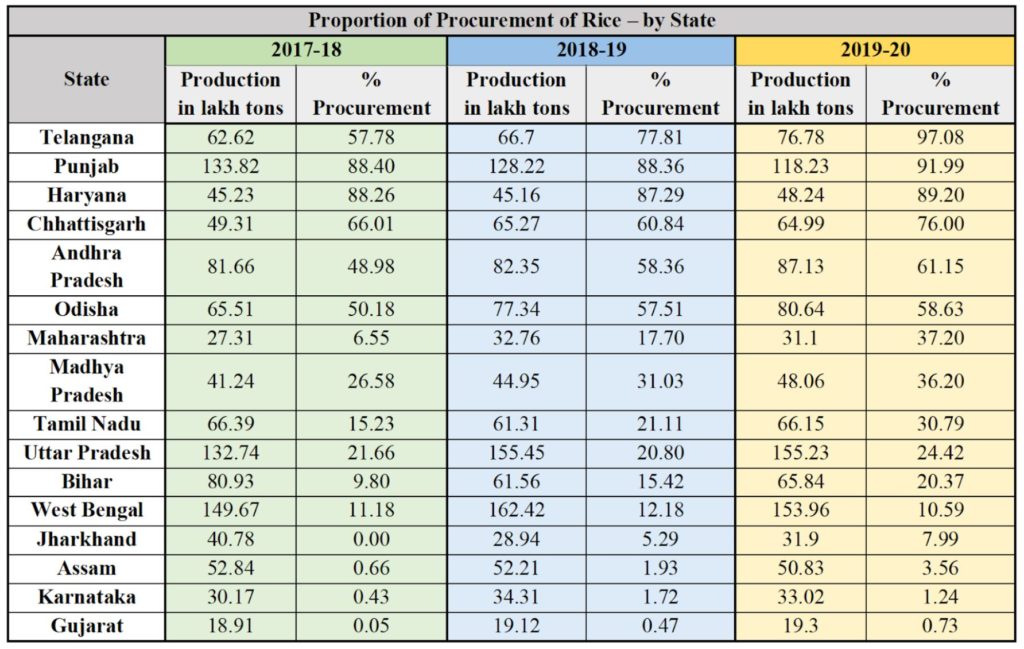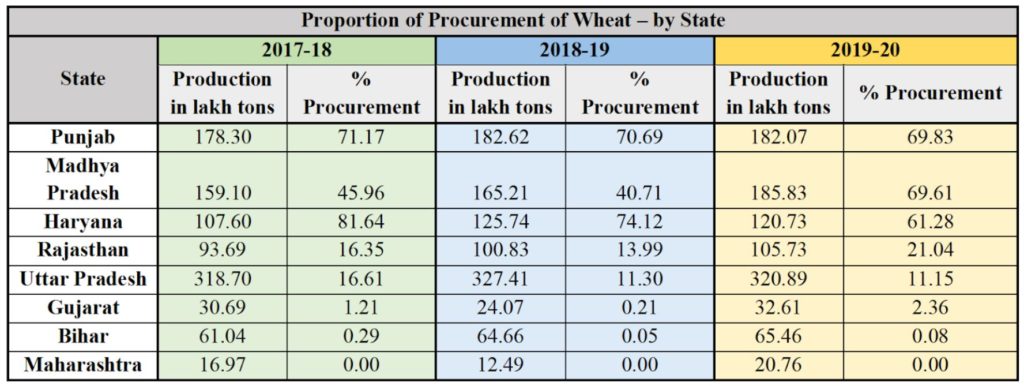One of the key arguments of those opposing the recently notified agriculture acts is that a large number of farmers are going to lose out on MSP procurement because of these bills. But what share of the total production of food grains, especially Rice & Wheat is procured by the government at MSP? Is this procurement even across the states? We find out.
On 28 September 2020, the President of India, Ram Nath Kovind gave assent to the three farm bills that were earlier passed by the parliament. Earlier on 17 September 2020, the Lok Sabha passed three new farm bills, namely:
- The Farmers Produce Trade and Commerce (Promotion and Facilitation) Bill, 2020
- The Farmers (Empowerment and Protection) Agreement of Price Assurance
- Farm Services Bill, 2020.

As per the government’s justification, one of the highlights of these bills is the freedom provided for farmers to directly sell their produce, thereby creating an opportunity to get a higher price for their crops. Although the government has stated that the MSP (Minimum Support Price) procurement system will continue, the new bills have become contentious with apprehensions being raised about income security of the farmers. The opposition has been alleging that these bills are a precursor to the government eventually doing away with MSP procurement. The clarification from the government do not seem to have assuaged the fears of the farming community and there have been protests by farmers across the country.
The opinion of the experts is divided on these new bills. While a few experts hail these bills as a 1991 moment for the Indian agriculture which will eventually fetch greater returns to the farmers, there are others who argue that the bills will do more harm than good for the farmers.
There are broadly two arguments from both sides. Those in favour of these bills argue that an open market will fetch a better price for the farmer because of the competition. The ones against base their argument on MSP being a saviour to the farmers. In this series, we take a look at both these arguments.
In the first story of this series, we look at numbers relating to MSP and the MSP procurement trend across the country and understand what proportion of the total production in the country is procured at MSP. We also look at state-wise MSP procurement trends to understand which states benefit the most today from the MSP regime.
MSP of Jowar and Ragi increased the greatest over the last 10 marketing years
We have earlier written an explainer on the role of FCI in procurement of the produce from the farmers at the MSP fixed by the government. Apart from fixing MSP for Rice and Wheat, the government also fixes MSP for Coarse grain like Jowar, Bajra, Ragi, Maize and Barley.
The MSP for Rice and Wheat, the largest produced crops has only marginally increased over the 10-year period (2011-21). For the Marketing year 2011-12, the MSP provided by the government for Paddy of Common type was Rs.1080 per quintal, while that of Grade-A paddy was Rs.1,110 per quintal. After a marginal increase year-on-year, there was a considerable increase for Marketing year 2018-19. For the Marketing year of 2020-21, the MSP for the two variants of Paddy is Rs. 1868 and Rs. 1888 respectively i.e. an increase by 73% and 70% respectively in these 10 years. During the same period, the MSP of Wheat increased by 64.5% i.e. from Rs. 1170 in 2011-12 to Rs. 1925 in 2020-21.
Meanwhile, the MSP for few of the coarse grains has increased considerably compared to Rice and Wheat. The two variants of Jowar i.e. Maldandi and Hybrid have increased by around 165% during the 10-year period.
Currently, Ragi is the crop which receives the highest MSP. For the Marketing year 2020-21, the MSP for Ragi is Rs. 3295 per quintal. It also has the highest increment during the 10-year period, the MSP has more than tripled from Rs. 1050 in 2011-12 to Rs. 3295 in 2020-21.
The MSP of Bajra has more than doubled in 10 years while the increase in the MSP of Maize and Barley is comparatively lesser.
The proportion of Rice procured at MSP has slightly increased over the last two years
During the five-year period 2015-20, the total production of Rice has increased from 1,044.88 lakh tons to 1,179.39 lakh tons. During this period, the MSP for Paddy (common) has increased from Rs. 1410 per quintal to Rs. 1815 per quintal.
Despite this increase in production, only a fraction of the total produce is actually procured by the government through FCI and state agencies. There has been a slight increase in the proportion procured by the government over the last two years. During 2018-19, out of the total production of 1,164.78 lakh tons, 443.99 lakh tons was procured i.e. around 38%. This is comparatively higher than earlier years where the procurement was around 1/3rd the total produce.
Meanwhile, the procurement in 2019-20 has increased to 43% of the total production. This can be attributed to the increase in the procurement targets from the government in line with the COVID-19 relief package announced by the government. As on 31 August 2020, around 510.12 lakh tons was procured of the 1,179.9 lakh tons of rice produced in 2019-20.
It has to be noted that even the procurement target set by the government is only around 35% to 40% of the total produce. It most years, the actual procurement is less than the set target. This was discussed in detail in an earlier story. As indicated earlier, the higher procurement in 2019-20, beyond the set targets is due to the increase in requirement to meet the demand of COVID-19 relief package.
Slight increase in the proportion of wheat procured but still below the set target
In 2015-16, the total wheat production in India is 922.88 lakh tons, whereas the procurement by the government was only around 25% of the total produce i.e. 229.62 lakh tons. This was also below the set procurement target of 330 lakh tones.
In the subsequent years, the production of Wheat increased every year, which also contributed towards an increased volume of wheat being procured. With the exception of 2018-19, the proportion of wheat procured out of the produce has also increased compared to previous year.
For the current market season i.e. 2020-21 the Government of India has set a higher target of 407 lakh tons anticipating a higher production. It ought to be noted that the production is computed for previous year (2019-20) while the harvest & procurement is done in the early months of 2020-21. For the production year 2019-20, as against the 1071.91 lakh tons produced, 389.83 lakh tons is procured. Although, as on date, it falls below the set target, it is still the highest procurement of wheat in a marketing season. For the ongoing season, the procurement is already 36% of the produce.
The quantum of MSP procurement is highly uneven across the states
While the numbers show an improvement in the proportion of rice and wheat being procured by the government at MSP, this is not even across the states. For few of the states, a major portion of the produce is procured by the government while for few others, the MSP procurement is bare minimum.
In the case of Rice, a major portion of produce in Punjab, Telangana, Haryana, Andhra Pradesh, Chhattisgarh and Odisha is procured by the government at MSP. Roughly around 90% of the rice produce in Punjab and Haryana is procured by the government. This explains the widespread protests against the farm bills in these two states.
The procurement from these states increased in 2019-20 in view of COVID-19 relief measures. It is more prominent in Telangana, where 97% of the production in the current year has been procured at MSP so far. Meanwhile, in Uttar Pradesh, Bihar and West Bengal, which are among the higher Rice producing states, less than 20% of the total produce is procured by the government at MSP.

This disparity can be seen even in the case of Wheat. As is the case with Rice, Punjab and Haryana have a significant portion of their production being procured by the government at MSP. The procurement from Madhya Pradesh increased in the current Market year, but on an average around 40-45% of the total Wheat produce in Madhya Pradesh is procured by the government at MSP. On the other hand, less than 20% of the produce in Rajasthan and Uttar Pradesh is procured at MSP. Meanwhile, the procurement by the government in Gujarat, Bihar and Maharashtra is next to zero.

MSP is helping, but only the farmers from a few states
It is apparent from the data that the government procurement of Rice and Wheat at MSP across the states is highly uneven and skewed towards certain states. While, there are limitations on how much the FCI can procure, an ideal situation would be the procurement distributed evenly across the states. MSP is helping the rice & wheat producing farmers, but only in a few states where the government is procuring substantial amounts. In the case of the other crops, the MSP procurement is very little across the country. There could be many factors influencing these disparities like the lack of FCI & related procurement facilities in few states, the availability of better or more remunerative procurement options or the FCI imposed state specific targets.
Hence, the argument that the new farm bills are going to rob farmers across the country of MSP procurement does not hold since the MSP procurement is highly skewed.
In the next story, we explore the possible reasons for the disparity among the states including open market price for certain crops and ascertain the impact the new farm bills could have on specific states.


